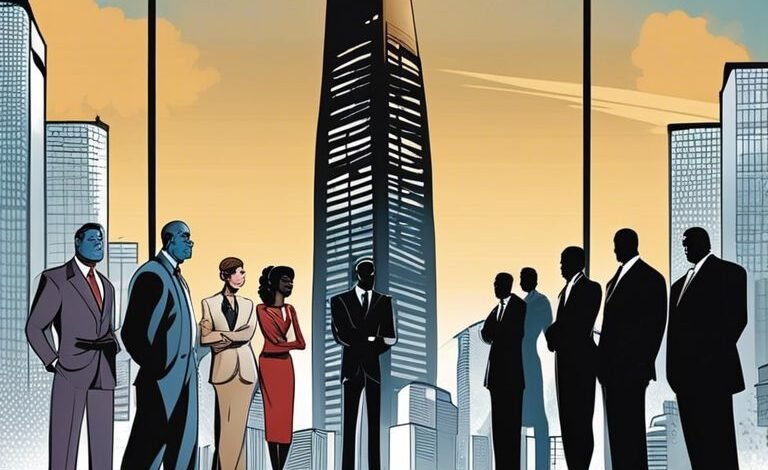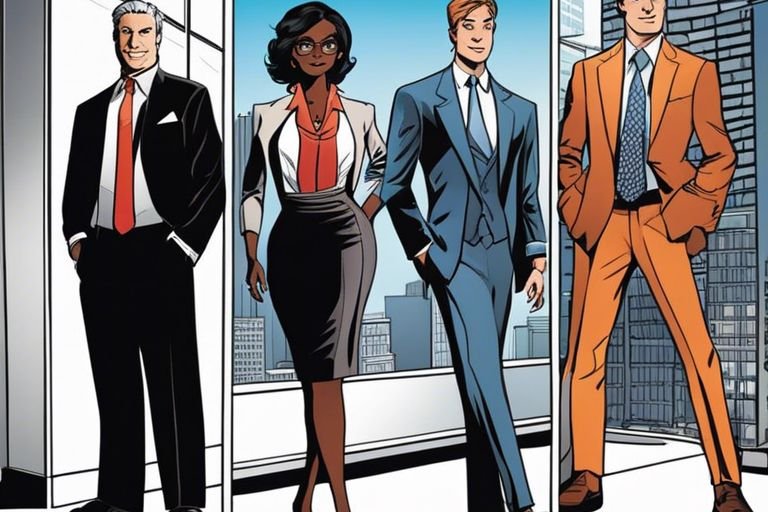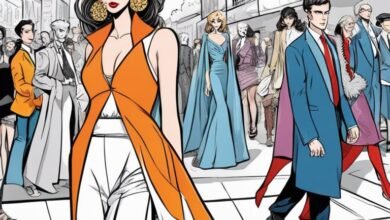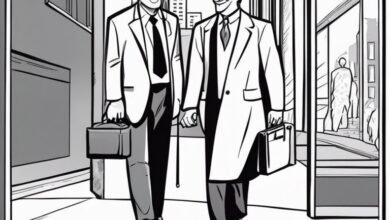
Decoding Business Formal Attire
Professional attire speaks volumes in the corporate world. Understanding the intricacies and expectations of business formal attire can set you apart and elevate your professional image. In this guide, we will uncover the key elements of business formal attire and provide you with imperative tips to ensure you always make a lasting impression. By the end of this article, you will have the knowledge and confidence to navigate any business formal setting with ease.
Thank you for reading this post, don't forget to subscribe!


The Fundamentals of Business Formal Attire
Before you research into the intricate world of business formal attire, it’s crucial to understand the key fundamentals that define this dress code. Business formal attire is the most professional dress code in the corporate world, typically reserved for high-stakes meetings, important presentations, or prestigious events. This level of attire exudes professionalism, sophistication, and a sense of authority. When in doubt about what to wear, opting for business formal attire is always a safe choice.
Defining Business Formal
The essence of business formal attire lies in its impeccable tailoring, classic color palette, and attention to detail. For men, this usually means a well-fitted suit in dark colors like navy, charcoal, or black, paired with a crisp dress shirt, conservative tie, and polished dress shoes. **The** key here is to ensure that your outfit is immaculately pressed and your shoes are well-shined to portray a sharp and polished look.
The Importance of Dressing Professionally
**The** way you dress in a professional setting speaks volumes about your credibility, competence, and respect for the environment you are in. Dressing in business formal attire not only commands respect but also instills confidence in your abilities. **The** attention to detail in your outfit shows that you value professionalism and are serious about your work. When you dress the part, you are more likely to be taken seriously and make a lasting impression on your colleagues and superiors.
Professionally, adhering to the business formal dress code sets you apart from the crowd and positions you as someone who means business. **The** right attire can boost your confidence and help you perform better in high-pressure situations, as you feel prepared and ready to tackle any challenges that come your way.
The Anatomy of a Business Formal Outfit
The Decoding Dress Codes: A Guide to Formal Attire is crucial in navigating the world of business formal attire. Understanding the key elements that make up a business formal outfit will help you make a lasting impression in professional settings.
Suits: The Backbone of Business Formal
An crucial piece of your business formal ensemble is a well-tailored suit. The right suit can project professionalism and confidence. Opt for classic colors like navy or charcoal gray for a timeless look. Pay attention to the fit – your suit should be tailored to flatter your body shape.
Pair your suit with a crisp button-down shirt and a conservative tie to complete the business formal look. Accessories like a leather belt and classic dress shoes can elevate your outfit further.
Investing in a quality suit is crucial for building a versatile and reliable business formal wardrobe. Make sure to choose fabrics that are durable and comfortable for long days at the office.
Shirts: Choosing the Right Fabric and Style
One of the key elements of your business formal attire is the shirt you choose to wear under your suit. Opt for high-quality cotton shirts in solid colors like white, light blue, or subtle patterns like stripes or checks. These classic options exude professionalism and complement your suit effortlessly.
Understanding the importance of well-fitted shirts is crucial in achieving a polished look in a business formal setting. Make sure your shirt is clean and well-pressed to maintain a professional appearance throughout the day.
Ties: Adding a Touch of Personality
Outfit your business formal attire with a tasteful tie to add a touch of personality to your look. Ties allow you to express your style while maintaining a professional appearance. Choose classic silk ties in solid colors or subtle patterns to complement your suit and shirt.
To complete your business formal ensemble, ensure that your tie is neatly knotted and falls at the right length. A well-chosen tie can enhance your overall look and make a powerful statement in professional settings.

The Role of Colors in Business Formal Attire
Now, if you want to master the art of dressing appropriately for a business formal setting, understanding the role of colors in your attire is crucial. According to Decoding The Office Dress Code: Everything You Need to Know, colors play a significant part in how you are perceived in the workplace. Let’s investigate how different colors can impact your business formal attire.
Neutral Colors: The Safe Bet
Business formal attire often calls for a conservative and professional look, making neutral colors like black, navy, grey, and white the safe bet. These colors are timeless, versatile, and exude a sense of sophistication and authority. **Opting for neutral colors in your business formal attire can convey a polished and put-together image,** making it a reliable choice for important meetings, presentations, or interviews.
Bold Colors: Making a Statement
Colors such as red, royal blue, emerald green, and burgundy can add a pop of personality and flair to your business formal outfit. **Incorporating bold colors strategically can make you stand out and leave a lasting impression,** showcasing your creativity and confidence. However, it is crucial to strike the right balance to ensure that your ensemble remains professional and appropriate for the workplace.
The role of bold colors in business formal attire is to inject a sense of energy and individuality into your look, **without compromising the overall professionalism required in a formal setting**. When used tastefully, bold colors can convey a sense of authority and style, setting you apart from the crowd while still adhering to the dress code expectations.
Patterns: Stripes, Checks, and More
Any business formal attire can benefit from the addition of subtle patterns like pinstripes, checks, or houndstooth. **These patterns can add depth and visual interest to your outfit,** breaking up the monotony of solid colors while maintaining a professional appearance. When incorporating patterns into your business formal attire, opt for understated designs that complement your overall look without overpowering it.
Patterns, when chosen wisely, can elevate your business formal attire and **showcase your attention to detail and sartorial flair**. They offer a sophisticated touch to your outfit and can help you make a subtle yet stylish statement in a formal business environment. Mixing and matching different patterns can add a touch of creativity to your look, **while still maintaining a professional and polished appearance**.
Accessories: The Finishing Touches
After meticulously choosing the perfect business formal attire, it’s time to focus on the accessories that will complete your polished look. Accessories can truly make or break an outfit, so it’s vital to pay attention to the details.
Shoes: From Oxfords to Loafers
On your feet, opt for classic leather shoes in styles like Oxfords or brogues for a sophisticated touch. Black or brown are safe choices that will complement most business suits. Make sure your shoes are polished and free of scuffs, as they can easily be noticed and can affect the overall impression you give off. Loafers can also be a stylish choice, especially in more relaxed work environments.
Belts: Leather, Suede, or Something Else?
On your waist, a quality leather belt is a must-have accessory. Match the color of your belt to your shoes for a harmonious look. If you want to add a touch of personality to your outfit, consider suede belts or ones with subtle patterns. A belt not only serves a practical purpose but also adds a layer of sophistication to your ensemble.
Touches: In terms of belts, remember that quality is key. Invest in belts made from genuine leather that will last you a long time. Avoid flashy buckles or overly embellished designs that can detract from the overall professionalism of your outfit.
Watches: A Touch of Elegance
Touch your wrist with a classic timepiece to exude elegance and attention to detail. A simple, well-crafted watch can elevate your outfit and showcase your punctuality and commitment to professionalism. Choose a watch with a metal or leather band that complements the rest of your accessories for a cohesive look.
Accessories: A sleek watch is a versatile accessory that can be worn with various outfits beyond business formal attire. Opt for a watch with a clean and minimalistic design for a timeless appeal that will never go out of style.
Business Formal Attire for Women
Unlike business casual attire, business formal attire for women requires a more polished and professional look. Concerning dressing in a formal business setting, it’s vital to pay attention to the details. Here is a breakdown of key elements to consider when putting together the perfect business formal outfit.
Suits: Tailored to Perfection
Tailored suits are a cornerstone of business formal attire for women. Invest in quality pieces that fit you perfectly, emphasizing your silhouette. A well-fitted suit not only exudes confidence but also shows that you pay attention to detail. Opt for classic colors like navy, black, or gray for a timeless look that can be easily mixed and matched with different blouses and accessories.
Choose a blazer with a structured shoulder and a tailored waist for a sleek and professional appearance. Pair it with matching trousers or a pencil skirt that hits just at or below the knee for a sophisticated touch. Make sure the hem of your pants is just right, grazing the tops of your shoes without dragging on the floor.
Concerning selecting a suit, remember that the devil is in the details. Pay attention to the fabric, lining, and overall craftsmanship of the garment. A well-made suit will not only last longer but also elevate your overall look.
Blouses: Fabrics, Necklines, and Sleeves
An vital component of a business formal ensemble is the blouse you pair with your suit. Opt for high-quality fabrics like silk, cotton, or satin that drape well and add a touch of luxury to your outfit. Choose classic colors such as white, cream, or light blue for a professional yet versatile look.
Consider the neckline and sleeves of your blouse when putting together your outfit. A crisp white button-down shirt with a pointed collar is a timeless choice that conveys professionalism. You can also opt for blouses with subtle details like ruffles or pleats for a feminine touch. Make sure your blouse is well-ironed and fits you comfortably without being too tight or too loose.
The key is to strike the right balance between modesty and style. Avoid plunging necklines or overly sheer fabrics that can detract from your professional image. Stick to classic styles that exude confidence and sophistication in a business formal setting.
Accessories: Scarves, Jewelry, and More
More accessories can elevate your business formal look and add a personal touch to your outfit. Consider adding a silk scarf in a classic print or color to complement your ensemble. Scarves can be worn around your neck, draped over your shoulders, or tied to your handbag for a chic finish.
Concerning jewelry, opt for **simple yet elegant pieces** that enhance your outfit without overwhelming it. A pair of pearl earrings, a minimalistic watch, or a delicate bracelet can add a touch of sophistication to your overall look. **Bear in mind, less is more when it comes to accessorizing in a formal business setting**.
To ensure your accessories don’t overpower your outfit, choose **subtle pieces** that complement your attire rather than compete with it. **Stick to classic styles and avoid trendy or oversized jewelry that can look out of place in a formal business environment**. Bear in mind, the goal is to enhance your professional image rather than distract from it.
Common Mistakes to Avoid
Keep Decoding Office Dress Codes in mind to steer clear of common mistakes when it comes to business formal attire. Making a fashion faux pas in the workplace can undermine your professional image, so it’s necessary to pay attention to the details of your outfit.
Over- or Under-Dressing
One common mistake to avoid is over- or under-dressing for the occasion. **Dressing too formally or too casually can create a negative impression** in a professional setting. It’s crucial to consider the dress code of your workplace and the nature of the event you are attending. If in doubt, it’s always better to err on the side of being slightly more formal than under-dressed.
Clashing Colors and Patterns
Avoid clashing colors and patterns in your outfit. **Combining conflicting colors or patterns can be distracting and unprofessional**. Stick to a cohesive color palette and limit the number of patterns you wear to maintain a polished and put-together look.
**Remember that subtlety is key when it comes to mixing colors and patterns in business formal attire**. Opt for classic combinations and avoid overly bold or busy prints that can overshadow your professional demeanor. When in doubt, keep it simple and sophisticated.
Poor Fit and Ill-Maintained Clothing
UnderDressing happens when your clothing doesn’t fit properly or is in poor condition. **Wearing clothes that are too tight, too loose, or in need of repair can detract from your overall appearance** and make you appear unprofessional. Make sure your garments fit well and are well-maintained to present a polished and competent image.
**Patterns that are too large or disproportionate can also throw off the balance of your outfit, making it look messy and unkempt**. Stick to appropriate sizes and proportions to ensure that your attire enhances your appearance rather than detracting from it.
To wrap up
Taking this into account, understanding the nuances of business formal attire is important for making a positive impression in professional settings. By decoding the expectations and guidelines for business formal wear, you can ensure that you are presenting yourself in a way that conveys professionalism and respect for the environment you are in. Recall, your attire is a form of non-verbal communication that can speak volumes before you even utter a word.
Furthermore, knowing how to navigate the world of business formal attire can give you a sense of confidence and empowerment in your professional endeavors. When you dress the part and adhere to the expectations of business formal dress codes, you are positioning yourself as someone who takes their career seriously and understands the importance of projecting a polished image.
In the aggregate, mastering the art of decoding business formal attire is a valuable skill that can set you apart in the workplace and help you make a lasting impression on colleagues, clients, and superiors. So, the next time you’re faced with a formal business setting, remember these guidelines and dress the part with confidence and style!
Q: What is considered business formal attire?
A: Business formal attire typically consists of a tailored suit in a neutral color, a dress shirt, a conservative tie, dress shoes, and dress socks.
Q: Are there any specific colors that should be worn for business formal attire?
A: Neutral colors such as black, navy, grey, and charcoal are typically recommended for business formal attire as they convey professionalism and sophistication.
Q: Should accessories be kept to a minimum for business formal attire?
A: Yes, when wearing business formal attire, it is best to keep accessories minimal and conservative. This includes opting for simple jewelry, a classic watch, and a subtle tie clip.
Q: Can women wear skirts or dresses for business formal attire?
A: Yes, women can opt for a tailored skirt suit or a dress paired with a blazer for business formal attire. It is important to ensure that the skirt length is appropriate and the overall look is polished and professional.
Q: Are there any specific guidelines for footwear when dressing in business formal attire?
A: Business formal attire calls for classic dress shoes such as oxfords or loafers in dark colors like black or brown. It is important to ensure that the shoes are polished and well-maintained to complete the professional look.




